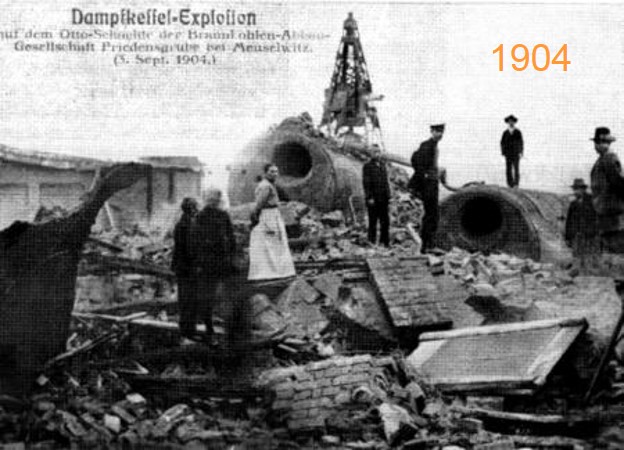PPS at the CSE
PPS Lessons learned
Lessons learned from events
PPS has been around for more than 150 years. Technical plants are becoming safer and safer, the number of incidents continues to decrease. Nevertheless, it can happen again at any time, as in Fukushima or the Gulf of Mexico. We must not let up. We must become even better.
We must maintain and further extend our competences!
Intensive involvement with PPS, good training, the company’s focus on PPS, learning from near misses / incidents and the continuous struggle to become even better creates the competence required to make technical systems really safe.
PPS 150 years ago
 Industrialisation began with the steam boilers. Low pressure (2 atm) was common in these boilers. The technological leap to higher pressures led to many boiler explosions. In only 5 years – from 1887 to 1892 – more than 100 explosions are documented. More than 270 people died. The technology was not “under control”. The manufacture and operation of these boilers had to be systematically checked. This was the beginning of plant safety. Even today, technological changes must be accompanied by systematic safety investigations. This is part of PPS.
Industrialisation began with the steam boilers. Low pressure (2 atm) was common in these boilers. The technological leap to higher pressures led to many boiler explosions. In only 5 years – from 1887 to 1892 – more than 100 explosions are documented. More than 270 people died. The technology was not “under control”. The manufacture and operation of these boilers had to be systematically checked. This was the beginning of plant safety. Even today, technological changes must be accompanied by systematic safety investigations. This is part of PPS.
open_in_new Seveso 1976
One of the most momentous events in the chemical industry took place in Seveso, Italy, in 1976. Trichlorophenol was to be produced there. The reactor was filled and heated in the afternoon. Later, the agitator was switched off, although the temperature was still very high. The heat of reaction could not be dissipated. The reactor contents became hotter and hotter. As is typical for runaway reactions, the temperature rise started slowly at first, but became faster and faster and ended in an exponential rise in pressure and temperature, which led to a discharge. A safety valve was used to discharge into the environment – there was no retention device. This released an unknown quantity[1] of 2,3,7,8-tetrachlorodibenzodioxin – also called “dioxin” – into the environment. The spreading toxic cloud drifted in a south-easterly direction and poisoned a 1 km × 6 km densely populated area of the municipalities of Seveso.
The next day, work continued at the plant. In the surrounding area, the leaves on the trees and bushes wilted, thousands of animals died. Although the plant management knew immediately after the accident that dioxin had been released, they did not officially announce it until eight days later, according to the technical director. It was not until days later that the population was evacuated.
Dieser Störfall führte in der Folge zur europäischen Seveso-Directive, aus der die deutschen Störfallverordnung abgeleitet ist.
open_in_new Bhopal 1984
The worst incident in a chemical plant occurred in Bhopal. During cleaning work, water flowed into a tank for methyl isocyanate (MIC) and subsequently led to a highly exothermic reaction. Carbon dioxide was released and the pressure inside the tank increased. The runaway reaction with gas formation led to a release of the reactor contents into the environment. Between 25 and 40 tonnes of methyl isocyanate and other reaction products (mainly dimethylamine, 1,3,5-trimethyl isocyanurate, 1,3-dimethyl isocyanurate) were released through the safety valve.
The protective devices did not function during this event. A separate cooling system was switched off about five months before the event. The caustic soda scrubber for removing gases that occurred was also demonstrably not functional. A flare to burn gases from the scrubber had been shut down for three months, and the connecting pipes between the two facilities had been dismantled for maintenance. The facilities were also not designed for the event.
By some estimates, between 2800 and 25000 people died directly and in the aftermath of this disaster.
The situation today
Incidents cannot be ruled out. However, with today’s systematic methods of process and plant safety, events can be reduced to a very large extent. This requires sufficient training (safety mind set), where safety is learned and then lived. A safety culture is required in companies where deviations from safety measures are not tolerated. And, of course, a very high level of technology is part of this. It must be constantly developed further.
Today, it is mandatory in the field of technology that events must be reported. Depending on the installation, the reporting thresholds vary. The causes of the events are analysed and should lead to a continuation of the state of knowledge.
In some countries, events are recorded in great detail in order to draw conclusions about the reliability of protective measures. This is difficult because such events occur rarely and therefore only allow for uncertain statistical statements.
The CSE Center of Safety Excellence is supported by responsible companies so that qualified young people ensure the sustainable maintenance of skills in industry through teaching and research in the field of process and plant safety.

